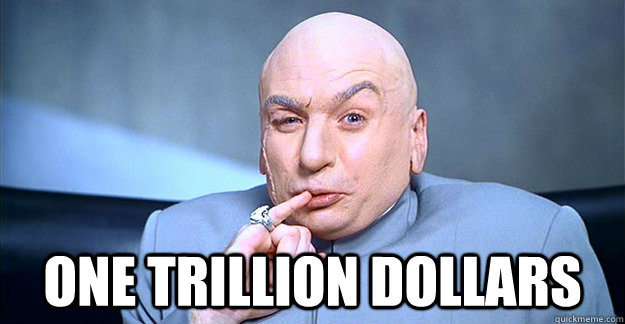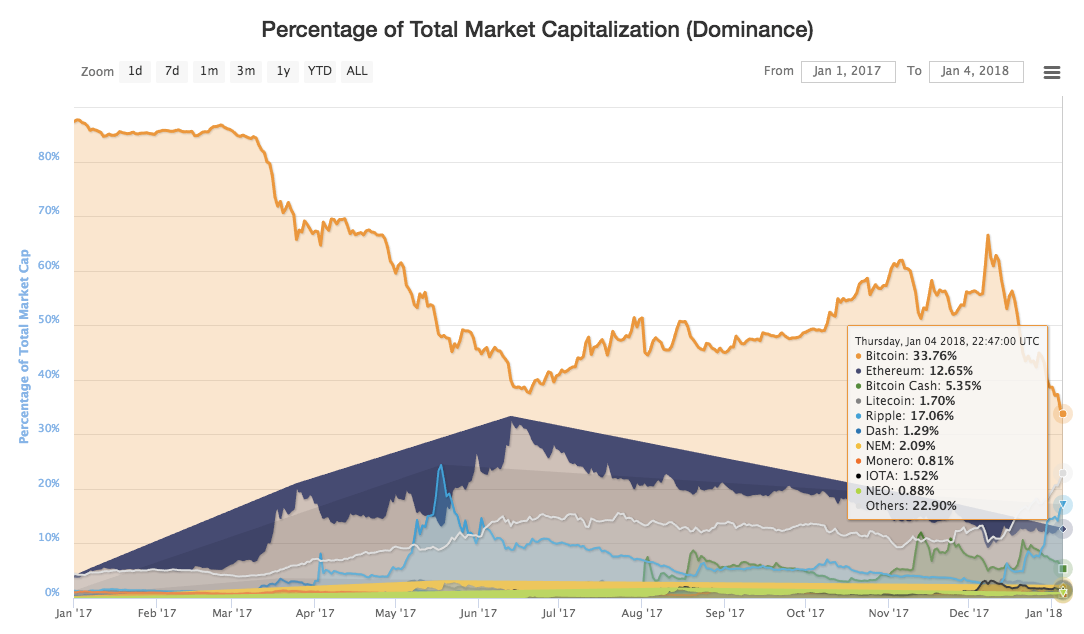The New Blockchain Internet Is Here
Freedom From The Grips Of BIG BROTHER
It's 2018 - Blockchain is on its way to Become the New Internet
Jan 4, 2018 · 8 min read
A new year has begun. Looking back to 2017 it was truly a wild ride on the crypto rollercoaster. Alt coins experienced massive growth and attention. Part of this can be credited to Bitcoin’s wild ride of all time highs, followed by massive corrections. Thankfully, hopefully, this is behind us.
Perhaps Bitcoin was the sacrificial lamb. Perhaps, the poster child. What Bitcoin most definitely did, was introduce cryptocurrency and the blockchain to the world. Whether people understood it or not, they threw money at it. To this day exchanges still have waitlists for new users, institutional money is slowly creeping into the market, and the influx of capital does not appear to be slowing any time soon.
Since the beginning of 2017 the industry has seen some insane growth.
- Bitcoin market cap $18 bil → $736 bil [USD]
- Total market cap (excluding Bitcoin) $2 bil → $481 bil [USD]
For the first time in history this gives the entire cryptocurrency/blockchain industry a market cap well over $1 trillion dollars!

Something interesting that you may have noticed from the values above is that the rest of the industry is growing (in terms of market cap) considerably faster than Bitcoin. In fact, in 2017 the rest of the industry grew 6x faster than Bitcoin.
To dive a little deeper, we can look at the percentage of total market cap of Bitcoin compared to the rest of the industry. Since December 1, 2017 Bitcoin’s market share has decreased from 55% to around 33% which has given way for dozens of other blockchain assets to break into the space.

If I were to be a betting man, in 2018 I would expect to see Ethereum overtake Bitcoin in regards to market share. Without doubt, Ethereum will continue to outperform Bitcoin as far as the team and technology goes. Bitcoin’s governance issues, reluctance to evolve, and extremely high fees may just lead it to its demise.
This being said, I do not think Bitcoin is going to die completely. Bitcoin will never die. And in the case that it does, then at least it will be succeeded by its hard-forked offspring, Bitcoin Cash. Which, I would mention, has a very real chance and overtaking Old Man Bitcoin.
The new Internet
Now, new year, new me, new mindset. If everyone who jumped on the Bitcoin bandwagon could understand one concept, I would love for it to be this.
Cryptocurrencies exists on the blockchain. The blockchain is essentially a new form of the internet. The two terms are not synonymous.
Blockchain technology will power Web 3.0, which I will refer to as ‘the new Internet’. For many this is an unfamiliar term, so here is a quick explanation I grabbed from this great read.
“Web 3.0 has many definitions, but one of the most popular is that of connective intelligence: where the next generation of applications, data, concepts, and people are connected by an unmediated fabric where you don’t need a trust broker like a bank or tech company in the middle to ensure privacy and security.”
A digital currency is a great proof of concept for blockchain technology, but quite frankly, it is one of the least interesting. Blockchain technology is truly quite amazing, and each day we are seeing new, innovative companies forming. As it currently stands, as far as I am concerned, the market is broken into 3 sections.
- Cryptocurrency (Bitcoin, Litecoin, Ripple)
- Platform (Ethereum, NEO, IOTA)
- Utility Token (TRON, EOS, Status)
Until now, the focus has been primarily on cryptocurrencies, but I think that in 2018 the platform and utility tokens will become the focus. Both of these components, more specifically the platform, are crucial because they help define the next generation of internet. This next generation of internet, or Web 3.0., will be comprised of a stack much like the following [ref link.]
- A decentralized transaction layer. (Ethereum — being the strongest)
- A decentralized file storage layer (IPFS and Swarm)
- A decentralized messaging layer (Matrix or Whisper)
- A high throughput computing resource (Golem)
As you can see, the first piece of the puzzle is the transaction layer, or as mentioned above, the platform. The leading blockchain platform is going to be the primary building block for the new internet, and as the current battle goes, Ethereum is winning.
Will Ethereum be the platform?
Ethereum is winning for several reasons. A strong & cohesive development team. Continuous evolution and improvements to their code base. Low transaction fees. But most importantly, the community.
I don’t see how permissioned blockchains that lack cryptoeconomic incentives will ever stand against public permissionless ecosystems. — Andrew Keys, ConsenSyS
As mentioned in this great article, the ecosystems with the most developers typically win. Ethereum already has a thriving developer community. Truffle, the smart contract developer framework, has 250,000+ developer downloads. Infura, which allows secure access to Ethereum and IPFS, now handles over 2 billion requests per day and smoothly scaled to peak at 4.5 billion requests per day one day in December. MetaMask, which brings Ethereum seamlessly to browsers, has over 500,000 active users.

What about the Utility Tokens?
Here’s where it gets interesting. A Utility Token essentially gives a user the ability to gain access to that system’s services.
For example, let’s look at Golem, a decentralized supercomputer. Golem is a global, open sourced, decentralized supercomputer that anyone can access. It’s made up of the combined power of user’s machines, from personal laptops to entire data centers. For users to utilize Golem’s service, to perform some supercomputing that they may need to do, they require Golem’s utility token, GNT.
This is just one example. Beyond this there are endless services that can be offered as utility tokens. This ranges from decentralized exchanges, to free content entertainment systems and infrastructures for decentralized apps to hedge fund and forecasting tools.
As it happens to be, a good majority of these utility tokens are built on top of the Ethereum platform. In order for these tokens to live on the Ethereum blockchain, they must conform to the rules and protocols that Ethereum has set, known as ERC20. So we can call these tokens, ERC20 tokens. What is interesting is that according to coinmarketcap, 91 out of the top 100tokens, by market cap, are ERC20. So nearly all of the largest utility tokens in the market are built on the Ethereum platform. This gives Ethereum quite the head start.
As the Internet commoditized the cost for communication, Ethereum commoditizes our costs of agreement and trust.
Looking Forward
2018 may just be the year of the token. It seems like every few days, new players are entering the game, raising millions, and generating massive market caps. Although the entire market is trending upwards, picking the real winners out of the pack at prices < $1.00 can deem quite profitable for an individual.
2018 in blockchain years is the equivalent of 1994 to the 1996 boom of the Internet. We are on the verge of Web 3.0
The number of decentralized apps (Dapps) that can be developed is endless. Here are some interesting avenues that are being explored .
The Operating System (Status)
- With Status your mobile device becomes a light client node on the Ethereum Network, enabling you to access Ethereum’s entire ecosystem from anywhere. Status is more than a messenger. Send payments and smart contracts to friends from within chats, and enjoy encrypted messaging by default, using a peer-to-peer protocol that doesn’t rely on centralized servers.
Monetization of open source code (Bounties)
- The Bounties Network makes it easy to outsource the completion of any task, from code to social marketing, and everything in between. No fees are taken on the bounties you create, encouraging any project to post bounties on all tasks, paying out in any ERC20 token or Ether.
Legal industry (Openlaw)
- OpenLaw is a blockchain-based protocol for the creation and execution of legal agreements. Using OpenLaw, lawyers can more efficiently engage in transactional work and digitally sign and store legal agreements in a highly secure manner, all while leveraging next generation blockchain-based smart contracts.
Supply Chains of the future (Viant)
- Viant is a blockchain-based platform for modelling business processes, tracking assets and building the supply chains of the future. Leveraging cryptographic security and smart contracts, Viant provides organizations verifiable insights as assets are managed and propagated through the entire supply chain.
- The scope of real world applications of this technology is huge! Just think about the size of the industries in the infographic below. On their own, they are massive, let alone collectively.

Scalable Network Capacity (Envion)
- The switch from PoW mining to PoS mining will significantly decrease the power required for a blockchain to run, but until that has been completely implemented, we will require physical mining operations. Not to mention, the need to meet market demand as more and more Dapps are introduced and the number of daily transactions across the blockchain continues to increase.
- Envion has built a highly profitable, global crypto-mining-infrastructure — Hosted in mobile, modular CSC containers — Decentralized placement directly at the energy source. The collapse in the price of solar-power panels has triggered an exponential expansion of new photovoltaic plants worldwide — leading to unprecedented local over capacities on sunny days. Envion can take advantage of this, while powering the blockchain.
Self-sovereign Identities (uPort)
- Register your self-sovereign identity, secure your keys and data, collect badges and credentials, login to decentralized apps, and digitally sign transactions.
- In November 2017, Zug, Switzerland piloted the self-sovereign identity platform and registered the first digital Zug ID on the Ethereum blockchain. A variety of services can be offered through uPort, such as e-signatures, parking fee payment, and an e-voting service. [The first citizen on uPort]
It’s going to be an interesting year!
With all of this said, it is going to be a very interesting year. Decentralized apps will continue to flood into the market, and we very well may see the platform for the internet of the future solidify itself within the market. Grab your popcorn, it’s going to be exciting.

Please note: nothing above is investment advice — you MUST do your own research — this space is unregulated and high risk to the uninformed and naive.
WRITTEN BY

